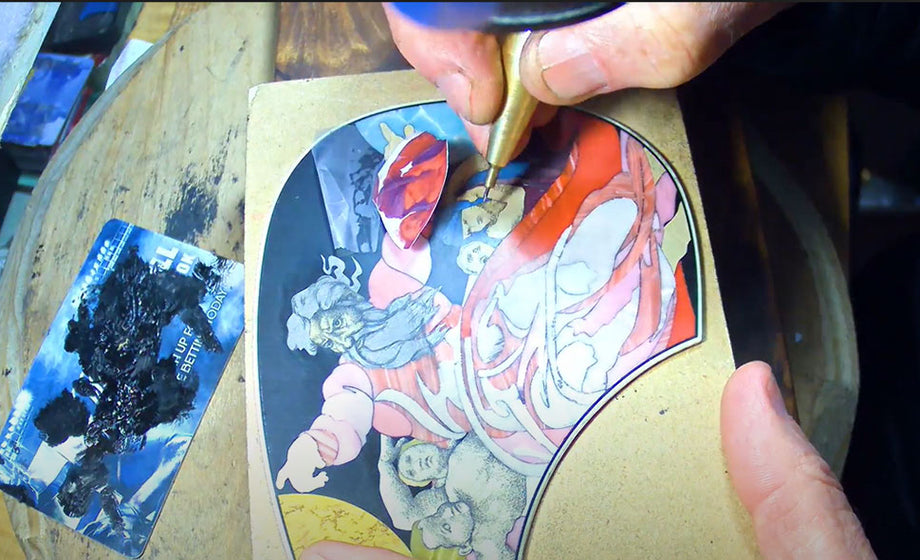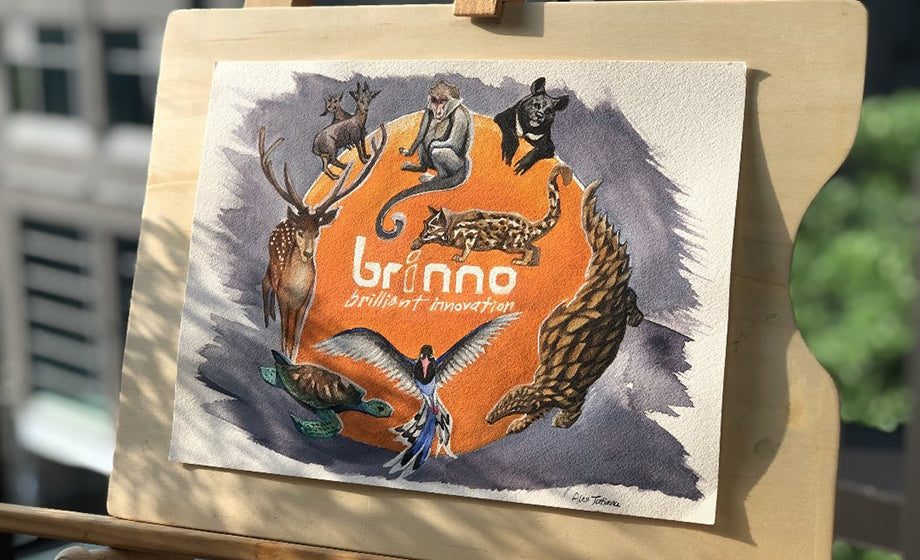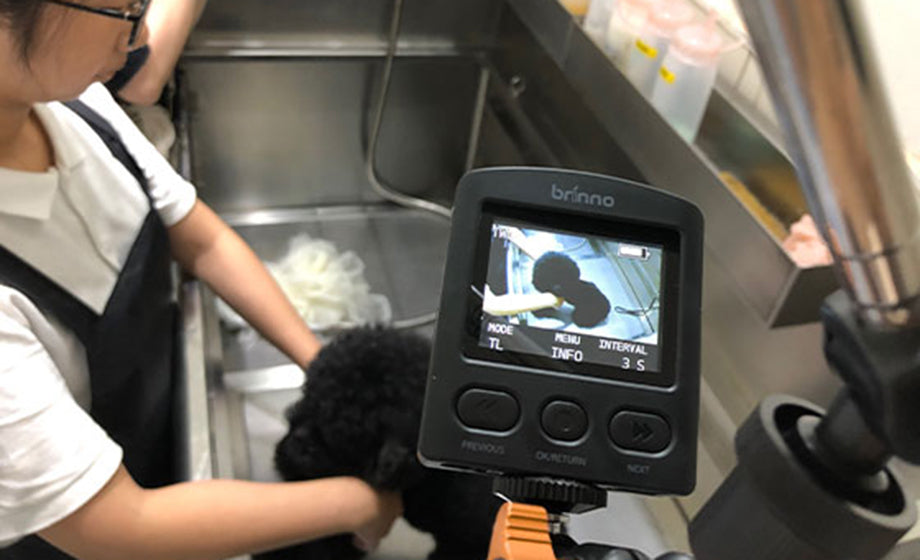Harvey Leach a luthier and Bob Hergert a scrimshaw artist are both considered among the finest artists in their respected fields. They have collaborated on a number of projects together throughout the years including the 1.5 millionths Martin acoustic guitar that is adorned with the art of Leonardo DaVinci and valued at over 1 million USD.
Customers are fascinated by the process of building musical instruments and because there are so many great choices these days the decision of which builder to choose often comes down to getting to know them. The best way to get to know a craftsman is to watch them work.
- Harvey Leach
Since October they have been collaborating on a Sistine Chapelinspired guitar for a collector who wanted to find a way to combine his two passions, guitars, and church. Their detailed work was captured using BrinnoBARD cameras and even though they were 500 miles apart, the cameras allowed them to compress two months’ work into a short video that gave the appearance that they were working in the same room.
We did a short interview with Harvey and Bob to learn more about their unique artistic backgrounds and professional experience.

Harvey (on the left) and Bob (on the right) in front of Harvey’s magnificent Samurai Guitar
Please tell us a bit about yourselves and your craft. How did you get started?
Harvey: I've been building musical instruments since 1972. I come from a musical family and my dad got me started in luthiery by having me repair old violins. For Christmas one year I got a book on playing the banjo by the legendary Earl Scruggs, in the back of the book was a section on building your own banjo and within that section 4 or 5 pages were dedicated to inlays. Pretty much everything I do now started from that book section.
After building a couple of banjos I started to build mostly guitars because for some reason guitar players were more open to instruments that weren't mass-produced by a well-known company. I've built over 450 guitars but now I focus mostly on inlays.
My specialty is creating very realistic plays and recreating the work of the Great Masters. I'm also the inventor of a unique guitar that folds in half for travel called Voyage Air which was featured several years ago on the TV show Shark Tank.
Bob: I started doing scrimshaw back in 1978. At that time I was selling prints of my pen and ink drawings. A jeweler who owned some of my work suggested I try scrimshaw and gave me some small ivory cabochons to work on. His simple advice was to scratch the surface and rub ink into the scratches. Through years of practice and experimenting, I refined my technique to what it is today.
Who are your customers?
Harvey: As an inlay artist I have worked with some of the most well-known and respected companies in the guitar industry; C.F. Martin, Gibson, Paul Reed Smith, Santa Cruz, and Collings as well as international companies like Farida. Eastman and B&G guitars. I also work for some of the best-known hand builders like James Olsen, Kevin Ryan, MikeBaranik, and Michihiro Matsuda to name a few.
As a guitar builder, some of my well-known customers include; Roy Clark, BradPaisley, Dolly Parton, Elliot Easton, Thom Bresh, John McEuen, and Rodney Dillard. Most of my customers however are not famous and either just want a guitar with a personal touch, like a pet or a name inlaid or they are guitar collectors. In a bit of irony, most of the 450 guitars had very little or no inlay on them. As a builder, I love adding some unique artwork but it's always nice to know that my guitars are good enough to stand on their own.
Bob: Three relationships directed my career. First was my introduction to Gary Kelley, a knifemaker and writer, who put my work in knife publications and introduced me to the world's top knifemakers.
Next was my relationship with custom cue stick makers. My work on collector cue sticks exposed me to an international market.
And finally, custom guitar makers found my work and allowed me to work on some of the finest guitars ever built. Besides working with Martin and Gibson Guitars, two of America's legendary companies, I have been able to work on one-of-a-kind guitars by the worlds' premier luthiers.
The Sistine Chapel as a guitar inlay is very unique, do you know the story behind the customer’s request?
Harvey: The customer is a collector of guitars and cars among other things. He and I first met after he purchased one of my one of a kind collaboration with C.F. Martin Guitars called The Hot Rod. Since then he has added several of my guitars to his collection including 3 guitars that Bob and I worked on together. One called the Apostle Guitar, one telling the story of Abraham Lincoln and the other featuring "Cars and Stars". The customer is also a retired pastor so for many years we have been discussing combining his love of the guitar with his love of the Church and what better way than the work of Michelangelo! The customer plans on loaning the guitar to the Museum of the Bible in Washington DC once it's completed.

What do you think are the advantages of using time lapse to document your artistic process?
Harvey: I have been thinking about this project for several years and one of the things that have kept me from starting was, given its epic nature, how can I document the process? In the past, I have simply taken still shots to try and capture the process but that method requires me to stop what I'm doing and take a picture. For me that creates 2 problems; first starting and stopping aren't conducive to the creative process and secondly, it's just hard to remember to stop! Once I heard about the BrinnoI realized it was the perfect answer. I can just set it up, turn it on and go about my business, and have great results. Given that this entire project will probably take a couple of years and since Bob and I live almost 500 miles from each other it will be great to have a tool that will compress that time into minutes and at the same time make it look like Bob and I are working in the same room. If this does end up as a museum display it will be great to be able to show visitors what they are looking at and what went into making it. One of the problems with my work has always been figuring out how to explain that it's a painting!
Would you recommend the Brinno BARD to other luthiers?
Harvey: I would definitely think this would be great for other luthiers. One of the unique "services" that many builders like to offer is what we call a "Baby Book" which is a compilation of images of the guitar being built from start to finish. I think having a time lapse video would be a fantastic addition to that and also be a great way to create web content. Customers are fascinated by the process of building musical instruments and because there are so many great choices these days the decision of which builder to choose often comes down to getting to know them. The best way to get to know a craftsman is to watch them work.
Where can people follow you?
Harvey: Many of my inlay work can be found at: http://www.harveyleachinlays.com/
Bob: Some of my work is on these webpages: www.scrimshander.com, www.bobhergert.com and www.scrimshaw.biz and I welcome others to visit me on Facebook at both Bob Hergert and Micro-Scrimshaw.
Learn more about the Brinno BARD and how you can use it to showcase with time lapse.



